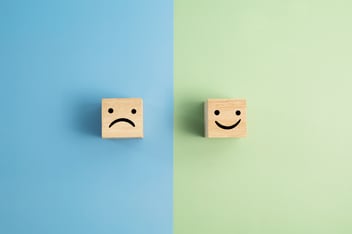No video selected
Select a video type in the sidebar.
By the time February rolls around, it's a pretty safe bet that a lot of those New Year’s resolutions have dried up faster than a puddle in the Mojave desert. It seems that most resolutions fall under the heading of getting healthy. Eating better, exercising more, dropping those extra ten pounds. And it begs the question: What exactly does it mean to be healthy? Maybe your body is a specimen of physical fitness. You can run ten miles, easy as you please, and you have rock hard abs, but you live in a state of constant fear and anxiety that when you step on the scale you might be one pound heavier than you were the day before. Are you healthy? Maybe you’re carrying around some extra weight and your cholesterol levels are too high, but you wake up every morning like a little joy bomb, passionate and ready to take on the day. Are you healthy? To a certain degree, the answer to this question is subjective. One person’s physical regimen might be another person’s vision of hell on Earth. Likewise, one person’s levels of joy and exuberance may feel a bit exhausting to others. But one thing is certain: Optimal health, whatever that might mean for you, requires a balance between the mental, the emotional, and the physical. If you want to get into better physical shape, it’s going to be hard to do if you’re living in a state of depression or overwhelm. And it’s difficult to improve your mental and emotional state when your body is constantly feeling sick and tired.
My journey into the practice of inner training began when I was around twenty years old. I had just moved to Santa Monica, California and was renting a room from a friend. She was a single mother, going through a rather nasty divorce, and she let me have the room for a couple hundred dollars a month. It was great for me because I was having trouble finding and maintaining steady work. This was due, in part, to the fact that I started feeling sick shortly after moving to California. I would experience bouts of extreme fatigue and stabbing pains in my stomach. Things got so bad that it was difficult for me to maintain a normal daily routine, and if I tried to exercise—even just a light workout—I would be in bed for days. Doctor after doctor couldn’t explain my symptoms, one even accused me of lying, but eventually I was diagnosed with Epstein Barr virus. Although I finally had a diagnosis to hang my hat on, I wasn’t satisfied that it explained the reasons for all of my maladies. As I mentioned, the friend I rented the room from was in the middle of a contentious divorce. It put significant stress on her and her kids and made for an uncomfortable home environment. The constant pressure to scrape up enough cash to pay the rent and feed myself left me in a perpetual state of anxiety and overwhelm. I was sure that these pressures were adding to, even magnifying, the effects of the virus in my body. I dove deeper into my inner training, believing that I would never improve physically until I got my mental and emotional houses in order.
It may not seem obvious on the surface, but our mental and emotional health is intricately connected to our physical health. (Just to note, when I say mental health, I’m not speaking of it in the clinical sense, but rather the state of our thoughts and how they influence our feelings and actions.) Let’s remember that our nervous system operates in one of two states, the sympathetic and the parasympathetic. The sympathetic, or fear-based nervous system is triggered when the brain perceives that we are in danger. Our heart rate increases in order to send more blood to the muscles, our senses are turned up to eleven, and “non-essential” functions such as digestion are shut down. This is the “fight or flight” response, and for most of human history it allowed us to escape from predators or defend ourselves from rival tribes. The physical experience of being inside the sympathetic response is what we call stress, and it’s only meant to be active in short bursts, just until the danger has passed. Today, most of us will never come face to face with a hungry lion, but we do encounter plenty of modern day stressors, and our brain doesn’t know the difference between the two. As far as our nervous system is concerned, a hard deadline at work might as well be a great white shark. But while the events that trigger our sympathetic response may not be actual dangers, the stresses that the body experiences as a result are very much real.
Many people live their lives with the sympathetic nervous system stuck in the on position and don’t even realize it. Ironically, the system that was constructed to protect your physical body from external threats now threatens your well-being because of your fear. And the more intense the fear-based emotion is, the greater its negative impact on your physical body. Chronic emotional stress constricts your blood vessels, which can lead to cardiovascular disease. Fear activates your adrenal system and drains energy from your digestive and immune systems. The release of hormones such as cortisol (which in small doses are actually helpful) impairs the immune system and can lead to chronic inflammation, which can be a precursor to multiple serious illnesses including Type 2 diabetes, autoimmune diseases, and even cancer. Maybe most insidiously, physical stress can create an emotion loop that might seem impossible to escape. For example, when the body feels stress, muscles tend to contract or “tense up.” When our muscles are chronically tense, it becomes harder and harder for them to relax, which inhibits their ability to function normally, and causes pain. The pain triggers a fear response, the fear response creates muscle tension and pain, which can lead to more fear-based emotional and thought patterns. On and on it goes, leaving you in a state of chronic pain.
A similar type of loop might occur when we take on the challenge of getting the body into better physical shape. Maybe you’ve been carrying around an extra fifteen or twenty pounds and you’ve decided you’re ready to take the action to get rid of it. One of the obstacles you might face is some kind of emotional connection with food. Stressors at work or in your personal relationships trigger that sympathetic response, leading to feelings of anger, anxiety, or resentment, and your go-to remedy is a big bowl of ice cream or a bag of hot Cheetos. Now you’ve committed to a strict regimen of physical fitness, but if you’re operating inside of that fear-based state, it’s going to be awfully tempting to pull out that Ben & Jerry’s after a particularly challenging day. You might even allow justification for it because, hey, you’re going to do an hour on the Peloton tomorrow morning. But if you’re not aware that those fear-based emotions are driving, pretty soon that hour on the Peloton every day becomes every other day, then a couple times a week, then catch-as-catch-can until, eventually, the stationary bike is a hat rack and those pounds aren’t going anywhere.
Getting to a place of physical fitness, whatever that might mean for you, requires first getting your mental and emotional states in alignment with your overall vision. The low intelligence of fear-based thoughts and emotions will constrict your ability to maintain a fitness regimen. Especially in today’s world of social media where we’re constantly inundated with images of all the beautiful people “living their best lives”. Never mind that most of that is complete bullshit, if you’re living in a space filled with doubt, fear, and shame, what’s going to light up when you’ve seen the thousandth photo of J-Lo rocking her 50 year-old abs? If you’re carrying around feelings of shame about your own body, your response probably isn’t going to be, “Oh, hell yes, sign me up for whatever she’s doing!” It will probably be more along the lines of, “Oh Christ, who am I kidding. I’ll never look like that.” Because that’s the language of fear-based thoughts and emotions.
Optimal health and vitality requires the alignment of all three aspects of health: mental, emotional, and physical. This is right in the wheelhouse of what we do in both our Power Series curriculum. We train the ability to still, focus and direct the mind to think thoughts and adopt beliefs that align with the vision we hold for our lives. We teach strategies and techniques that allow us to become aware of our emotions, shift them and cultivate them to align with our vision. And we train how to leverage our emotional and mental health to achieve the physical health outcomes we want. If we can line up our emotion loop with the actions needed to get the physical results we want, that's power!
Here’s what one client had to say as a result of her training: “I went from feeling incredibly frustrated and hopeless with my body to a place of empowerment and strength…The most meaningful practice for me has been…evaluating whether my expectations are appropriate, and if they’re not appropriate, really being able to let them go in a physical way…not holding the tension, or sadness, or fear in my nervous system any longer but truly letting it go, and that’s freedom.”
You too can get your mental, emotional and physical states in alignment when you sign up for our Power Series. Click HERE for more information and start your journey toward health and vitality today!



